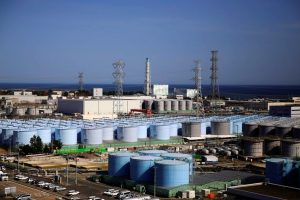Japanese officials are abandoning past goals to reduce the country's reliance on nuclear power and plan to develop “next generation reactors” to meet ambitious new clean energy goals.
Nuclear power has taken a backseat in Japan since the 2011 Fukushima disaster triggered scrutiny of the industry's safety practices.
But with growing concerns about energy security and a goal to reduce carbon emissions to zero by 2050, nuclear power is back in Japan's energy policy.
AF ALSO REPORT: Russian oil tanker sinks in Black Sea, US warns of 'Dark Fleet'
According to the revised draft of the basic energy policy, Japan's Ministry of Industry and Commerce hopes that nuclear energy can meet 20% of Japan's electricity demand by fiscal year 2040.
While this is in line with the 20% to 22% target for 2030, the new plan cancels the previous goal of “minimizing reliance on nuclear power.”
It also includes plans to build innovative next-generation reactors at nuclear power stations owned by operators who decide to retire existing reactors.
Naomi Oshita, Asia Pacific Power and Renewables Power Markets Assistant at Wood Mackenzie, said: “Governments are finally realizing the importance of nuclear power as it can provide the country with affordable energy and stable loads, while data centers require energy 24/7.
“Nuclear power and data centers go well together,” Oshita added.
In the years after the Fukushima nuclear accident, Japan sharply reduced its reliance on nuclear power and increased its use of fossil fuels, which account for 70% of total electricity generation.

But with Russia's war in Ukraine, soaring coal and gas prices and supply disruptions in 2022, the government wants to use nuclear power more to ensure a stable energy supply.
However, using nuclear power to meet growing electricity demand will be a challenge for Japan due to regulatory hurdles, public opposition, high costs, severe earthquakes and lengthy development times.
Experts say The country may not meet its 2030 nuclear power target due to public resistance and slow regulatory approval. They say adding new nuclear capacity is also difficult, given that it can take decades to build nuclear power plants.
Nuclear power will account for 8.5% of the country's electricity supply in 2023.
Coal and wind power policies are unclear
Officials also plan for renewable energy to account for 50% of the electricity mix by 2040.
This would be roughly double the 22.9% share of renewable energy in fiscal 2023 and exceed the 2030 target of 36% to 38%.
But renewable energy advocates criticized the draft, citing the lack of a roadmap to phase out coal-fired power generation.
By 2040, the use of thermal power, especially the use of inefficient coal-fired power plants, will decline from 68.6% in 2023 to 30% to 40%.
Mika Ohbayashi, director of the Renewable Energy Research Institute, also pointed out that the target share of wind power is smaller, between 4% and 8%, while the target share of nuclear power is 20%. This could leave Japan lagging behind in wind power compared with other global markets.
Still, some analysts said the newly proposed energy plan was more realistic than existing targets for 2030 and suggested the government wanted to attract investment in renewables including batteries and continue to use liquefied natural gas as a transition fuel.
The draft also calls on governments and the private sector to secure long-term LNG contracts to hedge against rising prices and supply disruptions.
“There is a need to utilize LNG for power generation as a realistic transitional means,” it said.
The energy plan is revised every three years and is expected to be finalized and approved by cabinet early next year.
- Reuters, with additional editing and input by Vishakha Saxena
Also read:
Energy emissions are about to peak, but it’s “too late” to meet climate targets
Survey finds Asian steelmakers failing to switch to renewable energy
Hopes grow China's emissions may have already peaked, or will peak next year
Asian Development Bank: Asian economies face risks from inaction on climate change
Fossil fuels will once again drive global emissions to record highs
Scientists say 2024 will 'almost certainly' be the hottest year on record
Indonesia's Prabowo vows to close coal-fired power plants within 15 years
Emissions from world's super-rich 'leading to economic damage and deaths'
What does Donald Trump mean for global carbon markets?




